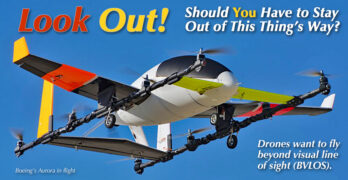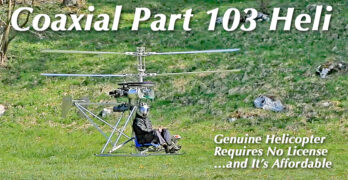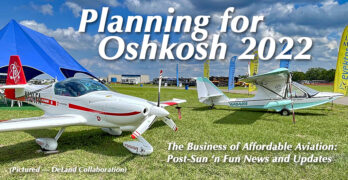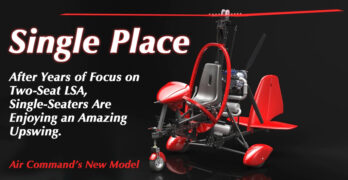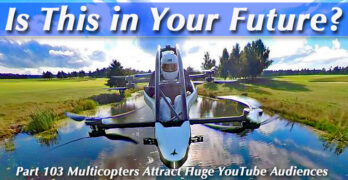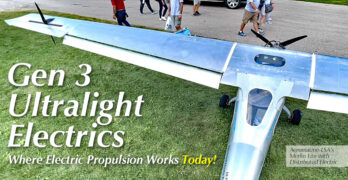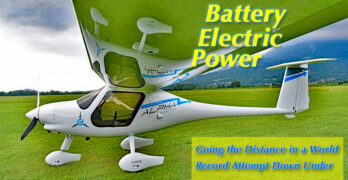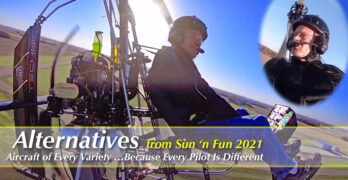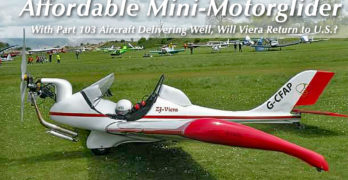Airspace from ground level to 400 feet is about to get really crowded. Keep alert, fellow pilots! Am I overstating this situation? I don’t think so.
You know about drones. You may not know they are presently restricted to visual line of sight. However, a line-of-sight drone won’t get your Amazon package delivered a few miles from the distribution center to your house.
Throughout Covid, a group has been working on potential changes to FAA regulations to allow drones to fly further, beyond visual line of sight (as military drones do now). It’s abbreviated BVLOS.
It is impossible to keep up with all the regulatory actions from dozens of agencies. Some of this stuff is dry as old bones. The document I’m focused on runs to 381 pages. If you’re a real glutton for punishment, read the whole thing.
The good news = This is only an industry committee report.
Search Results for : multicopter
Not finding exactly what you expected? Try our advanced search option.
Select a manufacturer to go straight to all our content about that manufacturer.
Select an aircraft model to go straight to all our content about that model.
Coaxial Helicopter that Meets Part 103… and You Can Afford It!
In a time of great spectator enthusiasm for STOL competitions, wouldn’t a VTOL be even better? If a super-short takeoff is cool, why not vertical takeoff?
Of course, most of the multicopter types — flying machines sometimes called eVTOLs — take off vertically but those are different, electric flying animals. Despite waves of breathless reporting by mainstream media types, eVTOLs are not yet ready for prime time. Even if you could buy one, you probably don’t want to pay for it. Most will be very expensive.
What if you could take off vertically this year and for a price you can actually afford?
Of course, rotary-wing enthusiasts can already choose a well-proven, made-in-the-USA helicopter that complies with Part 103 and is very affordable… for any aircraft type, but almost absurdly low-cost compared to conventional helicopters. I refer to the Mosquito XEL from Composite FX (see this video), which sells for $52,000 ready to fly or $42,000 in kit form.
NEWS Update — Started at Sun ‘n Fun… Preparing for AirVenture Oshkosh 2022
My moment of truth is fast approaching. Will I succeed or fail to predict the future?
I have been repeating my forecast that FAA will announce a draft of their newest regulation, called an NPRM (Notice of Proposed Rule Making) at EAA’s big summer celebration of flight. I’m not betting the farm, though. I think it’s a fairly safe prediction.
To win an increase in their budget a few years back, FAA agreed to complete a new regulation by December 31, 2023. That new reg is widely known as Mosaic; its full name is Modernization of Special Airworthiness Certification. Because FAA has said the agency needs 16 months to read every comment and adjust the final regulation language accordingly, seeing the future is simple math. Go back in time 16 months from the end-of-year deadline in 2023 and you end up at… yep! — AirVenture Oshkosh 2022. We will see if they meet their goal.
Single-Seat Surge Continues: Air Command’s New One-Place Gyroplane
I am longtime enthusiast of single place aircraft. Clearly, I am not alone. In fact, the number of pilots showing an interest in single-place aircraft has been growing fast according to several ways of estimating such interest.
When you fly solo you can operate your flying machine the way you want — well… within the laws of physics and the laws of FAA (or whatever national CAA you must obey). What you don’t need to do is worry about a passenger.
Single place aircraft are commonly much more affordable.
Despite following single place aircraft closely, even I have been astounded at steadily increasing interest in single place aircraft over the last few years. Although significantly out of sight of many aviators, single place aviation has been growing faster than you imagine. Some pilots actually think Part 103 “died” a couple decades back. I don’t know how it feels to be that wrong, but they are.
LSA-Sized eVTOL Takes a Different (Ducted) Approach — Reasonably Priced?
I promise I will not keep reporting futuristic eVTOLS or multicopters. However, since the Jetson One article went over better than expected and since I’ve focused mainly on Part 103-sized multicopters, how about one that is LSA-sized?
I still would not follow one multicopter article with another except for developer Doron Merdinger, saying this, “Suggested [selling price is] $135,000 to $150,000.” That got my attention. From what I’ve seen so far, any eVTOL larger/heavier than a Part 103 entry is way, way more expensive.
Beyond that come air taxies… 4-6-8 seater urban air transport aircraft. Those I will never report as they are commercial by design and cost far beyond any Sport Pilot’s budget. In addition, it could be years before they actually enter the market.
Can Doroni Do It?
However, a two-seater, ducted-fan, LSA-like aircraft with a 500 pound payload for $135-150,000 could actually be something some readers might consider.
Are We Current Sport Pilots and Our Aircraft an Endangered Species?
By my study and reports from several other organizations, the world has somewhere north of 1,000,000 pilots. That estimate includes all airline, military, GA, and recreational pilots even including hang glider and paraglider pilots and sky divers. One million, more or less.
Now, as anyone who has not been vacationing on Mars the last couple months probably knows, another new multicopter is captivating YouTube gazers.
Dubbed Jetson One after the famous TV cartoon from decades past, this small vehicle is certainly intriguing… even if you are one of many current-day pilots who dismiss these aircraft. The video below has been viewed more than 14 million times in three months!
Not only haven’t we seen the last of this, more likely this is just the beginning.
No, Not Air Taxis…
Recreational Multicopters
Look, this article is not about air taxis or so-called UAM vehicles (Urban Air Mobility, according to some who enjoy making up new names for these multi-motored flying contraptions).
AirVenture Day 4: Generation 3 Ultralight Electrics — Where Electric Propulsion Works Today
A mid-week demonstration featured Europe’s Volocopter and America’s Opener BlackFly. The two (three actually, a pair of BlackFlys flew) demonstrated their eVTOL flying capability. They could hardly have been more different.
Billionaires are investing in, uh, what to call them? …drones, multicopters, eVTOLs, UASs, UAVs, Powered Lift aircraft, the list literally goes on and on. The lack of a widely accepted generic name is one of several indications these air taxis of tomorrow are still in a fairly distant tomorrow.
Two industry experts gave me their judgment after viewing the Volocopter and BlackFly demonstrations. Both agreed the Volocopter presented better, performing a true demonstration of its vertical launch then transitioning to forward flight, manuevering, and then doing a landing. Both also said the BlackFly was much less impressive. “They just kind of bobbed and floated around, not doing any maneuvering or making a transition to forward flight,” each agreed. Both wanted to like each aircraft but one clearly won in their minds.
Going the Distance on Battery Power — Record Attempt Reveals the State of Art in Electric Propulsion
Does Alpha have the tiny little motor that could?
Article updated 6/22/21 —DJ
That sounds like an old childhood story (“The Little Engine that Could…”) but here we are in the new millennia with electric cars, huge wind farms, vast solar collector projects, biofuels, and more. Subsidies are pouring in to electric projects around the globe. Hundreds of developers building “urban air transport” multicopters are raising millions of dollars.
Will human-flown conventional aircraft join the electric parade? One company has pursued the electric dream further than most.
This story is about a group in Australia that aimed to set a new world record, one of a rather different sort.
In this case the team plans a “record attempt flying a Pipistrel Alpha Electro plane,” Australia and USA Pipistrel dealer Michael Coates wrote. “[The flight] will start at Parafield Airport at 7:00 a.m. on Saturday June 19, 2021.” Total distance, Michael added, will be 1,150 kilometers, which “will shatter the previous record of 750 kilometers flown in September 2020 in Germany.”
This project hopes to break the previous distance by more than 50 percent.
Sun ‘n Fun 2021 / Reflections 2.0… Powrachute, Gyro Technic, Stick-On Autopilot, Duc Props
We continue with further coverage from the first major airshow in almost two years… THANKS to Sun ‘n Fun 2021 for helping present these interesting aircraft and more.
This article has news …about two aircraft in a category I refer to as “alternative aircraft” …about an easily-mounted autopilot you can actually afford …and the success story of a French prop maker now well established in the USA.
Alternative aircraft is my umbrella term for weight shift aircraft (trikes), powered parachutes, gyroplanes, carriage-equipped powered paragliders (not the same as powered parachutes), Light-Sport motorgliders, and Light-Sport Lighter-than-Air flying machines. These unorthodox, not-mainstream aircraft have maintained a steady share of sales; around 100 new such aircraft enter the U.S. market every year.
Counting all types, the “alternative aircraft” sector may account for a quarter or more of all LSA sales. Alternative aircraft have attributes that drive customer inquiries: better affordability and unique flying qualities.
A New Year and Part 103 Aircraft Keep Coming — Here’s Viera and Desire
As work on my Part 103 List continues, I have reached out to producers of the lightest, most affordable airplanes you can buy. The list is now 54 producers and yet I am aware more may show up to be counted. That’s good. More choice in affordable airplane benefits pilot consumers.
In 2020, the most-read articles appearing on this website were about affordable aircraft — updates describing FAA’s new regulation for Light-Sport Aircraft were also popular.
After a decade or more when many pilots believed Part 103 ultralights had all but disappeared, I am delighted to say those people were simply wrong. Part 103 is very alive and well, perhaps healthier than at any time since the category was created in fall of 1982. The volume of people visiting this website — up more than 50% in 2020 — and a majority of those visitors choosing to read about 103s provide numerical proof that interest in these aircraft is large and growing.


